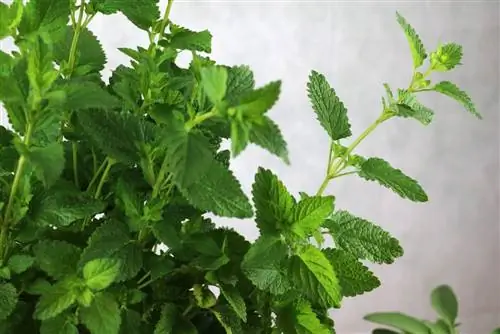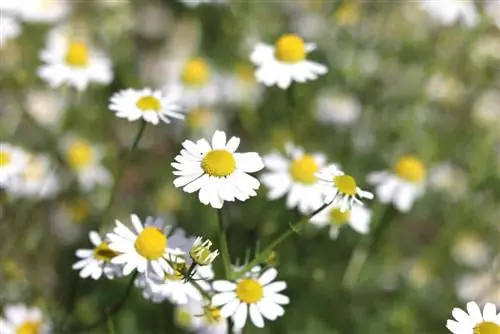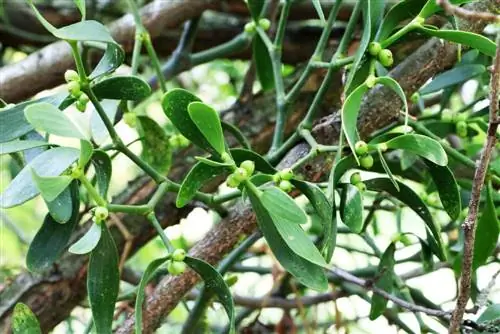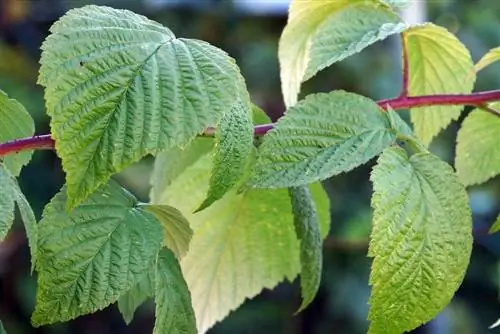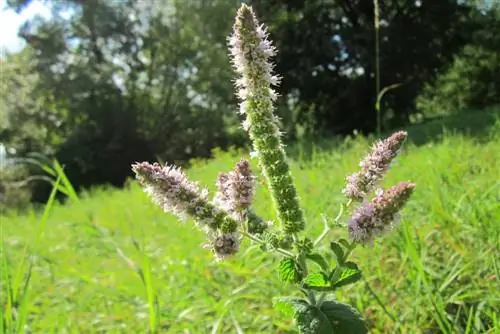- Author admin [email protected].
- Public 2023-12-17 03:39.
- Last modified 2025-01-24 12:45.
Mint (Mentha) belongs to the mint family and is considered one of the best-known medicinal plants. Essential oils create the fresh aroma typical of all types of mint. The medicinal herb is used as a tea for colds and sore throats. It is added to medicinal baths and relieves headaches. Mint is used in refreshing drinks, desserts and treats. We introduce you to 12 varieties for home cultivation.
Cultivation
Most mint varieties are perfect for growing in the garden. If you don't have a garden, you can also achieve good results on the balcony or on the windowsill. The plant needs loose, nutrient-rich soil and sufficient moisture. Choose a sunny to partially shaded location. Note that mint forms extensive roots and proliferates both above ground and below ground. Root barriers and continuous pruning are recommended.
Mints are considered very robust plants. They are often attacked by aphids, flea beetles, mint bears and fungal diseases such as powdery mildew and mint rust. Mints are hardy and can overwinter outdoors covered with brushwood. Mints in a bucket need a protected location on the wall of the house or in the basement. We recommend a cover made of jute or bubble wrap for protection.
Popular varieties from A to E
Pineapple Mint (Mentha suaveolens variegata)
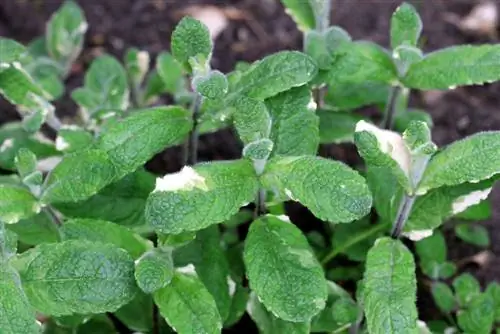
A very beautiful variety is the pineapple mint with its white-edged, slightly hairy leaves. Pineapple mint impresses with its fruity pineapple aroma and the milder menthol taste. It is often used for children's teas.
- Height: up to 70 centimeters
- Harvest: May to October
- Flowers: light pink
- Use as a medicinal herb: antispasmodic, cooling and antipyretic, anti-inflammatory
- Use as a herb: Tea, salads, desserts, bouquets
Tip:
If you rub the white-edged leaves of pineapple mint between your fingers, you will be treated to a wonderful scent of pineapple. Arranged in the vase, just a few stems of pineapple mint spread a wonderful scent into the home.
Applemint (Mentha rotundifolia)
Apple mint is one of the most popular fruit mints. It exudes a wonderful aroma. The variety has a low menthol content and is suitable for children's teas.
- Height: 60 to 80 centimeters
- Harvest: May to September
- Flowers: white
- Use as a medicinal herb: relieves inflammation of the oral mucosa, calming, relaxing
- Use as a herb: Tea, soft drinks, desserts, syrup, liqueur, vinegar, bouquets
Basil Mint (Mentha piperita x citrata Basil)
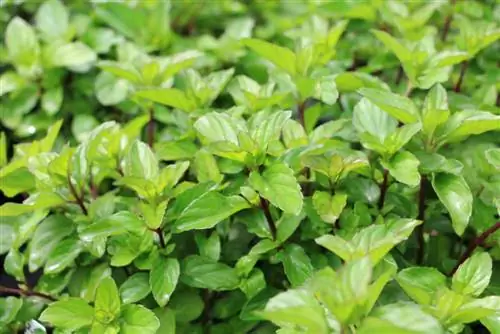
The basil mint combines the spice of basil and a slightly peppery taste with a fresh mint aroma. This mixture is perfect for preparing pesto and Mediterranean dishes.
- Height: 60 to 80 centimeters
- Harvest: May to September
- Flowers: purple
- Use as a medicinal herb: anti-inflammatory, calming, refreshing, cooling
- Use as a seasoning herb: Pesto, soups, salads, vegetable dishes
Strawberry Mint (Mentha Species)

Strawberry mint is one of the smallest varieties of mint. But the delicate plant impresses with its wonderful strawberry aroma. It places few demands on its location and grows outdoors as well as on the balcony or on the windowsill.
- Height: 30 to 50 centimeters
- Harvest: May to September
- Flowers: light purple
- Use as a medicinal herb: Relieves cold symptoms, coughs and hoarseness, reduces bad breath, has a relaxing effect on stomach and intestinal problems
- Use as a herb: Tea, desserts, liqueur, soups, salads, cocktails
Popular varieties from L to P
Lavender Mint (Mentha Species)
The lavender mint does not proliferate as much as other types of mint. She is delicate and grows slowly. It exudes a pleasant, sweet scent and is ideal for making scented bouquets, potpourris and additives for relaxing baths.
Lavender mint is very important in Mediterranean cuisine.
- Height: 40 to 50 centimeters
- Harvest: May to September
- Flowers: light purple
- Use as a medicinal herb: relaxing, calming, relieves sleep disorders
- Use as a herb: Mediterranean vegetable dishes, scented bouquets, bath additives
Moroccan Mint (Mentha spicata var. Crispa Morocco)
Moroccan mint comes from Morocco, where it is traditionally made into tea and drunk with a lot of sugar. It was created from curly mint (Mentha spicata).
- Height: 40 to 60 centimeters
- Harvest: May to September
- Flowers: light purple
- Use as a medicinal herb: Relieves cold symptoms and sore throats, antispasmodic, digestive
- Use as a herb: Tea, cocktails, lemonade, salads
Tip:
For a quarter liter of refreshing mint tea you need a stalk of peppermint or Moroccan mint. Pour 250 milliliters of boiling water on top. Let the tea steep for 10 minutes and enjoy the he althy drink. If you want, you can sweeten the mint tea with honey.
Nana mint (Mentha spicata var. crispa Nane)
The Nana mint comes from the Near East. It is also known as Turkish mint. It is used in oriental cuisine to season dishes. Nana mint is mainly drunk with black tea and lots of sugar. Nana mint is milder than peppermint and is considered better tolerated.
- Height: 60 to 80 centimeters
- Harvest: May to September
- Flowers: pink
- Use as a medicinal herb: Relieves cold symptoms, anti-inflammatory, calming, promotes digestion
- Use as a herb: Tea, cocktails, salads, yogurt, dips
Orange Mint (Mentha piperita citrata)
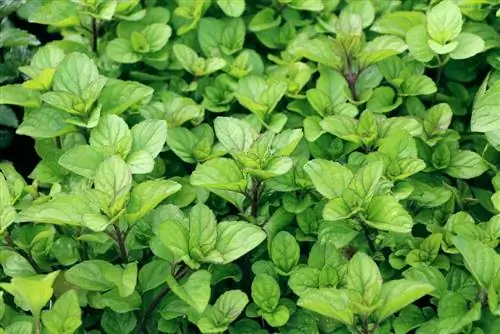
The orange mint impresses with its refreshing aroma of ripe oranges. The variety's menthol content is low, making orange mint ideal for children's teas.
- Height: 40 to 60 centimeters
- Harvest: May to September
- Flowers: pink
- Use as a medicinal herb: antispasmodic, cooling and antipyretic, anti-inflammatory
- Use as a herb: Tea, salads, desserts, mint vinegar, scented bouquets and potpourris
Tip:
A pest that likes to attack orange mint is the mint bear. The iridescent green beetles are pretty to look at. If not de alt with in time, they will eat up your mints within a short period of time. Watch out for the beetles in spring and collect them carefully. This stops mating and your plants are protected from the voracious beetle.
Peppermint (Mentha x piperita)
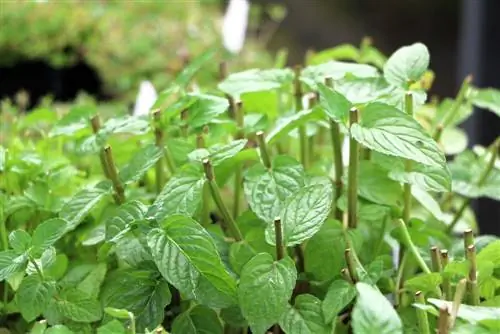
Peppermint has been used for centuries. It was created from brook mint and forest mint. It is also known as English mint or garden mint.
By the way, peppermint is considered one of the most important herbs in British cuisine. Even meat dishes are served with aromatic peppermint sauces. Peppermint is also often used in Arabic cuisine to refine rice and bulgur dishes.
- Height: 50 to 65 centimeters
- Harvest: May to September
- Flowers: white-purple
- Use as a medicinal herb: Relieves cold symptoms, sore throats and headaches, digestive, antispasmodic
- Use as a herb: Tea, cocktails, ice cream, sweets, sauces, salads
Note:
Peppermint tea is he althy, but should not be drunk all the time. The high menthol content can lead to irritation of the stomach lining if consumed regularly. Mild mint varieties such as apple, orange or strawberry mint contain less menthol and are gentle on the stomach.
Popular varieties from S to Z
Chocolate Mint (Mentha x piperita var. piperita Chocolate)

If you expect chocolate mint to taste like chocolate, you will be disappointed. The mint variety got its name from its use in English mint tablets. Nevertheless, chocolate mint is a wonderful culinary herb that gives sweet dishes with or without chocolate a wonderful taste.
In contrast to most other mints, the plant prefers a partially shaded to shady location.
- Height: 30 to 60 centimeters
- Harvest: May to September
- Flowers: violet blue
- Use as a medicinal herb: antispasmodic, calming, nerve-strengthening, cooling
- Use as a herb: Tea, cakes, desserts, ice cream, cocktails
Tip:
The flowering, fragrant varieties of mint attract bees, bumblebees, butterflies and many beneficial insects.
Watermint (Mentha aquatica)

Water mint is also known as stream mint. The swamp plant is widespread across large parts of Europe, in swampy areas, on stream banks and wet meadows. Water mint is one of the Druids' sacred herbs. It has been used as a medicinal plant for centuries.
- Height: 20 to 50 centimeters
- Harvest: May to September
- Flowers: light purple
- Use as a medicinal herb: Relieves stomach and gallbladder problems, helps with insomnia, reduces headaches
- Use as a herb: Tea, bath additives
Lemon mint (Mentha gentilis var. citrata)
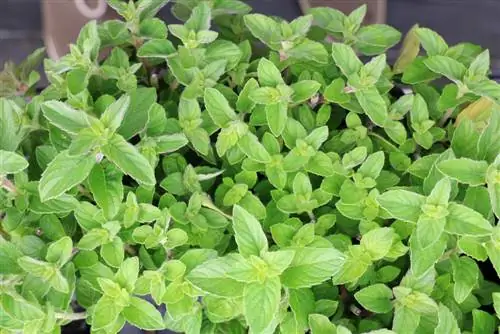
The lemon mint pampers you with a wonderful citrus scent paired with a touch of menthol. Lemon mint is ideal for making scented bath oils.
- Height: 20 to 40 centimeters
- Harvest: May to September
- Flowers: light purple
- Use as a medicinal herb: Relieves cold symptoms, calming, nerve-strengthening, invigorating, anti-inflammatory
- Use as a seasoning herb: Smoothies, tea, desserts, liqueur, soups, salads, aromatic oils
Tip:
A foot bath with mint is wonderfully relaxing in summer and winter. Add five stalks of your favorite mint to a liter of hot water and let the mixture steep for ten minutes. Pour the mint water into a suitable container. Fill the foot bath with two liters of hot water and enjoy the effect.


